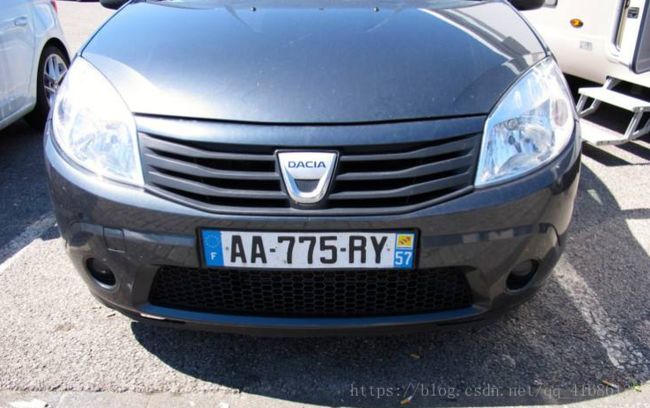python实现车牌识别
某天回家之时,听到有个朋友说起他正在做一个车牌识别的项目
于是对其定位车牌的位置算法颇有兴趣,今日有空得以研究,事实上车牌识别算是比较成熟的技术了,
这里我只是简单实现。
我的思路为:
对图片进行一些预处理,包括灰度化、高斯平滑、中值滤波、Sobel算子边缘检测等等。
利用OpenCV对预处理后的图像进行轮廓查找,然后根据一些参数判断该轮廓是否为车牌轮廓。
效果如下:
test1:
test2
实现代码如下(对图像预处理(滤波器等)的原理比较简单,这里只是对一些函数进行调包):
import cv2
import numpy as np
# 形态学处理
def Process(img):
# 高斯平滑
gaussian = cv2.GaussianBlur(img, (3, 3), 0, 0, cv2.BORDER_DEFAULT)
# 中值滤波
median = cv2.medianBlur(gaussian, 5)
# Sobel算子
# 梯度方向: x
sobel = cv2.Sobel(median, cv2.CV_8U, 1, 0, ksize=3)
# 二值化
ret, binary = cv2.threshold(sobel, 170, 255, cv2.THRESH_BINARY)
# 核函数
element1 = cv2.getStructuringElement(cv2.MORPH_RECT, (9, 1))
element2 = cv2.getStructuringElement(cv2.MORPH_RECT, (9, 7))
# 膨胀
dilation = cv2.dilate(binary, element2, iterations=1)
# 腐蚀
erosion = cv2.erode(dilation, element1, iterations=1)
# 膨胀
dilation2 = cv2.dilate(erosion, element2, iterations=3)
return dilation2
def GetRegion(img):
regions = []
# 查找轮廓
_, contours, hierarchy = cv2.findContours(img, cv2.RETR_TREE, cv2.CHAIN_APPROX_SIMPLE)
for contour in contours:
area = cv2.contourArea(contour)
if (area < 2000):
continue
eps = 1e-3 * cv2.arcLength(contour, True)
approx = cv2.approxPolyDP(contour, eps, True)
rect = cv2.minAreaRect(contour)
box = cv2.boxPoints(rect)
box = np.int0(box)
height = abs(box[0][1] - box[2][1])
width = abs(box[0][0] - box[2][0])
ratio =float(width) / float(height)
if (ratio < 5 and ratio > 1.8):
regions.append(box)
return regions
def detect(img):
# 灰度化
gray = cv2.cvtColor(img, cv2.COLOR_BGR2GRAY)
prc = Process(gray)
regions = GetRegion(prc)
print('[INFO]:Detect %d license plates' % len(regions))
for box in regions:
cv2.drawContours(img, [box], 0, (0, 255, 0), 2)
cv2.imshow('Result', img)
#保存结果文件名
cv2.imwrite('result2.jpg', img)
cv2.waitKey(0)
cv2.destroyAllWindows()
if __name__ == '__main__':
#输入的参数为图片的路径
img = cv2.imread('test2.jpg')
detect(img)



